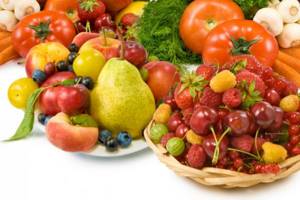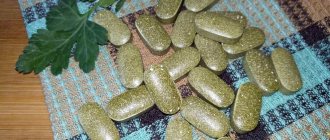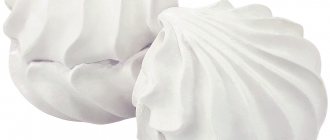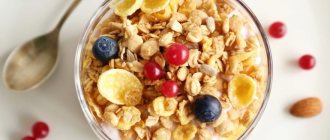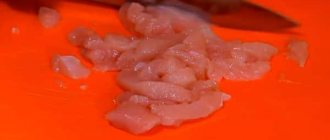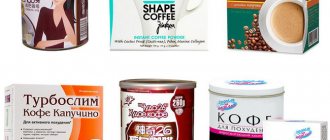Today we will prepare a delicious natural sweet - jelly based on apple pectin. This incredibly healthy substance will help us make a very tasty dessert, indispensable in the summer heat. With the help of jelly you can quench your thirst, fill yourself up and get a dose of vitamins, a boost of vigor and rejuvenation.
Pectin removes radionuclides from the body, lowers cholesterol levels and improves intestinal function. This substance is obtained from fruit juice, mainly from apples. Apples owe many of their benefits to their high content of pectin substances.
Pectin can be purchased in specialized spice departments or in Ayurvedic pharmacies. When buying pectin in a regular store, pay attention to the composition of the product: it is better to use pectin in its pure form without impurities (citric acid, sugar, etc.) The product packaging should be labeled “for jelly.”
The preparation of pectin jelly has some peculiarities. Now we will share with you all the intricacies of making jelly - incredibly tasty and healthy. This sweetness is very easy to prepare; even novice cooks can handle this recipe.
Jelly with apple pectin recipe
Nov 15 • Uncategorized • 138 Views • No comments on the entry Jelly with apple pectin recipe no
Contents
The jelly will appeal to both adults and children. Jelly can be considered one of the best desserts at any time of the year.
Desserts made from jelly are perfect for the holiday table: a tasty and light dessert will come in handy when you have already eaten a lot of fatty and high-calorie foods. And the bright colors of the jelly will decorate any holiday table.
Jelly can be made from juice, compote, jam, milk and dairy products: sour cream, cream, cottage cheese, yogurt. Multi-colored bright jelly with fruits, from fresh and frozen berries - the variety of types of jelly depends only on your imagination and taste.
Jelly can be used to decorate cakes and cookies, which will reduce their calorie content.
How is pectin used in confectionery?
Pectin enjoys well-deserved popularity among confectioners (both professional and amateur) and is a worthy competitor to the more expensive agar-agar and the thickener of animal origin - gelatin. A thickener made from apple pomace is popular in confectionery production, and citrus pectin is used in the production of juices and dairy products.
How to make jelly at home?
The main ingredients when making jelly at home are fruit and berry juices, sugar and gelling agents: gelatin, agar-agar and pectin.
But jellies are also very popular, made, it would seem, initially not from traditional products: jellies from milk, sour cream, kefir, tea and coffee.
How to make homemade jelly from gelatin
Edible gelatin is a natural product of animal origin. Gelatin is obtained by processing various parts of the body of cattle, mainly bones. Gelatin is used for cooking marmalade, mousses, jellied meat, various jellied dishes, and of course jelly.
Today, several types of gelatin are produced: powdered, plated and instant gelatin. Therefore, when preparing jelly, you must follow the instructions indicated on the gelatin package. But there are still general rules.
To make your homemade jelly delicious, take note of these little tips.
Powdered gelatin and in plates must be filled with water before preparation for swelling and better dissolution. You can use fruit or berry juices.
Powdered gelatin is usually soaked for 30-40 minutes . Then the gelatin is heated, stirring constantly until it is completely dissolved. Gelatin is not brought to a boil. The best option for preparing gelatin: in a water bath. The gelatin is then filtered through a fine strainer or cheesecloth and mixed with the liquid to make the jelly.
The gelatin in the plates is soaked in water for 10-15 minutes . Next, it is prepared in the same way as powdered gelatin.
Now instant gelatin is on sale. This kind of gelatin is not for
pre-soaked, and immediately added to the liquid for making jelly and heated.
If we talk about proportions, then traditionally 1 teaspoon of gelatin is added to 100 grams of liquid.
How to make jelly with agar-agar
Agar-agar is a product of plant origin. It is produced from red and brown algae containing a large amount of polysaccharides. Jelly with agar-agar is denser and stronger. Pairs perfectly with pieces of fruit and berries. The only disadvantage when preparing jelly with agar-agar: you need to check it every time, because... Different batches of agar-agar may differ in quality and properties. This is easy and simple to do: place a small amount of jelly in the freezer for a few minutes. If the jelly is not frozen, add a little more agar-agar.
When using agar agar to make jelly at home, soak it in cold water for 40 minutes and then boil it with the amount of liquid specified in the recipe.
How to make jelly with pectin
Pectin is a gelling substance of plant origin. Pectin is found in large quantities in plants, vegetables, fruits, and berries. Pectin is perfect for making homemade jelly. And preparing jelly takes less time than using gelatin. Homemade fruit or berry jelly made with pectin has a rich fruit and berry aroma.
When using pectin for homemade jelly, you must strictly follow the recommendations indicated on the package, because Industrially produced pectin may differ in its properties.
You should also not put too much pectin into homemade jelly: the jelly will not lose its taste, but will lose its color transparency. Jelly cannot be digested, because like gelatin, pectin loses its properties at high temperatures.
And, of course, you should not use expired pectin.
Well, the question of the benefits of jelly and the need to use it is something that few people ask. Most people don’t eat it often, because preparing natural jelly with pectin takes time, but few people want to buy store-bought stuff in bags, seeing the long list of all kinds of artificial additives and flavor enhancers.
I think that many of you remember how, in childhood, our mothers and grandmothers conjured a small portion of jelly - boiled berries, soaked the gelatin, filtered it and poured it into bowls. In general, the process is labor-intensive, and the output is minimal, eaten in a matter of minutes. We have long been accustomed to the fact that, as a rule, ordinary gelatin is used as a gelling base. Sometimes agar-agar is used, but it is difficult to digest and leads to bowel movements.
Much more beneficial is pectin, which is distinguished by its ability to massage and cleanse the intestines of waste products from the body. In addition, it helps remove heavy metal salts from the body.
What conclusions can be drawn from all of the above? Of course, if you prepare jelly, it is better to use pectin for this, combining the taste and benefits of the prepared dish.
Usually, when hearing the word “jelly”, many people have associations with a dish made from fruit juice. But traditional jellied meat is also jelly, only prepared on the basis of animal products. There are also milk, fish and even tea jelly.
We will offer you several recipes for jelly using pectin so that you can get a powerful dose of vitamins, a boost of energy, benefit your body and prepare it in a matter of minutes.
Ideas for jelly
To make the jelly especially tasty, you can add a few drops of wine or lemon juice to it when preparing it. To prevent lumps from forming when combining the gelling base with the fruit base, the bottom of the bowl into which the jelly is poured must be warm. It is not recommended to use aluminum dishes for jelly, as it produces an acidic reaction that is harmful to health and affects the taste and color of the jelly.
Jelly can be prepared in different ways, depending on the use of gelling agents. The easiest way is to buy instant jelly powder in the supermarket and dilute it with water in the specified proportion. This jelly powder can be of different colors; pieces of this jelly can be used to decorate cakes and pastries, creating interesting decorative compositions.
But a healthier recipe for making jelly is jelly made from gelatin, agar-agar seaweed or pectin. By preparing jelly based on these substances, you get an absolutely natural, and also healthy product. The fact is that pectin helps remove harmful substances from the body, rejuvenates the body and even prevents cancer. Agar-agar is rich in calcium, fights toxins and is no less useful than pectin. Agar agar helps the jelly mass swell, resulting in a wonderful, rich jelly. You can buy pectin and agar-agar in Ayurvedic pharmacies or specialized spice and seasoning stores.
Gelatin is a product of animal origin, namely an extract from animal bones. It is believed that gelatin contains substances that are beneficial for joints and prevent arthritis.
Well, the question of the benefits of jelly and the need to use it is something that few people ask. Most people don’t eat it often, because preparing natural jelly with pectin takes time, but few people want to buy store-bought stuff in bags, seeing the long list of all kinds of artificial additives and flavor enhancers.
Recipes for jelly with pectin:
1. Redcurrant jelly
- currant berries – 500g,
- sugar – 100g,
- pectin – 25g
- Prepare red currant puree using a blender or mixer.
- Add a little water and cook for 5 minutes.
- Strain the finished compote through a sieve.
- Dilute sugar and pectin in the prepared broth.
- Cook for another 5 minutes, stirring constantly.
- Pour the finished jelly into bowls.
2. Jelly with honey and parsley
Ingredients:
- water – 500ml,
- honey – 500ml,
- apple cider vinegar – 100ml,
- chopped parsley – 10 tbsp.,
- pectin – 80g
- Bring water to a boil and add chopped parsley.
- Leave for 15 minutes.
- Strain the finished broth and pour in honey and vinegar.
- Place on fire and bring to a boil.
- Add pectin and cook for 1 minute.
- Pour into any convenient container and cool.
3. Raspberry jam
- sugar – 2kg,
- raspberries – 2kg,
- butter – 1 tbsp.,
- pectin – 3 tbsp.
- Prepare berry slurry from raspberries.
- Add sugar and pectin.
- Place on low heat and cook, stirring constantly.
- When the jam boils, add butter and simmer over low heat for 5 minutes.
- Pour into jars and close with lids.
4. Sea buckthorn jelly
Ingredients:
- sea buckthorn juice – 500ml,
- sugar – 1.2 kg,
- pectin – 30g
- Squeeze the juice from the sea buckthorn and pour it into the pan.
- Put on fire and add pectin, bring to a boil.
- Add sugar and let simmer for 5 minutes.
- Pour into jars and store in a cool place.
5. Plum jam
- plums – 1.5 kg pitted,
- lemon juice – 1 tsp,
- sugar – 1.5 kg,
- water – 200ml,
- pectin – 30g.
- Combine plums, water and lemon juice.
- Let it boil and cook for 10 minutes.
- Add sugar and pectin.
- Bring to a boil and cook for 1 minute.
6. Strawberry confiture
Ingredients:
- strawberries – 1kg,
- sugar – 400g,
- water – 150ml,
- lemon juice – 2 tbsp.,
- pectin – 50g
- Mash the strawberries, pour in lemon juice and add sugar.
- Mix everything thoroughly and leave the mixture for 10 minutes.
- Pour water into a saucepan and pour pectin into it. Bring to a boil and cook for 1 minute.
- Pour the finished syrup into the strawberries and cook for another 4 minutes.
As you can see, dear readers of “Live Easy!”, there are a huge number of options for making jelly with pectin. Cook for the health of your family and friends!
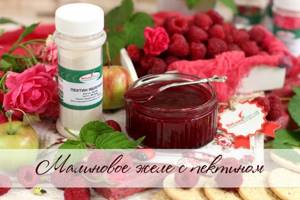
Ingredients
10g. pectin 400g. water 100g. any fruit
Making jelly
Dilute pectin in 200 ml. water and stir until the solution acquires the consistency of jelly.
Place the washed fruits in the rest of the water and bring to a boil. If you use citrus fruits or berries, then first you need to squeeze the juice out of them into water, and then put the pulp in the same water and boil it all together.
Strain the broth, put it back on low heat and pour the prepared pectin into it.
Turn off the heat, stir, pour into molds and cool.
How to make raspberry jelly with pectin?
All chefs who love to prepare sweet homemade preparations have recently begun to use such a substance as pectin. Don't you know him yet? Then you will be interested here!
All about pectin
“Why do you need pectin at all?” - you ask? And in order to forget about outdated methods of making jam according to grandmother’s recipes, prolonged boiling of berries, loss of the original color and most vitamins! This “magic” food additive will help you quickly thicken fruit and berry syrups, reduce the amount of sugar, reduce the cooking time, and get a chic appearance and excellent consistency of jam! Along with gelatin and agar-agar, pectin is also a gelling agent and can also be used to make jams, preserves and puddings, for example, like this raspberry jelly with pectin.
Pectin also has its own distinctive features, which allow it to be classified as a modern super-food. At its core, it is soluble fiber, which is a favorable environment for beneficial bacteria. And since pectins are practically not absorbed by our body, they additionally act as sorbents and can remove harmful substances from it, ranging from pesticides to radionuclides.
How to use pectin?
Working with pectin is not difficult, but there are a number of nuances that need to be paid attention to. The structure of pectin is such that it begins to work actively in an acidified environment, and sugar increases the ability of this polysaccharide to gel. Therefore, if you want to learn how to thicken jam with pectin, you should first examine your fruit and berry raw materials for jam for the content of your own (natural) pectin, and also read all about pectin in our article.
There are three groups of fruits and berries, in which the content of natural pectin varies greatly:
- The first group - apples, blackberries, cranberries, currants, gooseberries, plums, quince. These fruits contain a lot of natural pectin, therefore, when preparing jam, you do not need to add additional pectin.
- The second group, with an average level of pectin content, includes cherries, raspberries, elderberries, and overripe apples. It is recommended to add pectin to jam made from these fruits and berries, otherwise you will end up with ordinary syrup instead of jam. In this case, you don’t have to add acid, since they contain enough of their natural acids. Keep this in mind if you prepare cherry jelly with pectin.
- The third group of very sweet berries and fruits, in which the content of natural pectin and acid is low - apricots, figs, peaches, nectarines, strawberries and pears. We recommend adding both pectin and a little acid to the jam made from these fruits. Therefore, if you want to make apricot jelly with pectin, be sure to add a little citric acid to it. This will start the process of emulsifying the sugar syrup and you will get a lovely thick consistency.
Additionally, it is necessary to study the pectin itself, how to use this powder, in what proportions and for what products.
In our online store you can buy pectin for making jam, jelly and preserves from any berries and fruits.
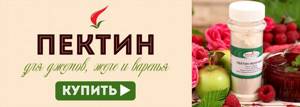
Regular apple pectin (yellow) is intended to give a viscous structure to preserves and jams. It makes all kinds of desserts very well, for example, orange jelly with pectin, apricot jelly with pectin, raspberry-apple jam and any jelly with pectin for the winter, incl. and juice jelly with pectin.
The second type of pectin, NH pectin, is suitable for creating berry and fruit layers, jelly coatings and dessert sauces. It is ideal for creating cake jelly with pectin or for making fruit marmalade with pectin.
The third type of pectin - FX58 pectin is suitable for you if you want to make milk jelly with pectin or sour cream jelly with pectin, since this pectin is able to work in an environment containing calcium, i.e. with all lactic acid products.
Our recipe for today with pectin is raspberry jelly based on apple pectin.
Types of pectin
All pectins are divided into two groups; the classification criteria are the ability to dissolve or not dissolve when heated, as well as the thickening mechanism:
- high methoxy pectin (HM);
- low methoxy pectin (LM).
Thickeners belonging to the first group require a lot of sugar and a certain level of acid to harden the mass. If the first substance is not enough, the mass simply will not set. Therefore, this type of pectin is chosen for the production of marmalade, preserves, and jams. HM pectins come in slow, medium and fast settling types. This category includes, among others, apple and citrus pectin. They cannot be reheated, otherwise the mass will no longer harden. In addition, citrus (yellow) pectin may lose its properties over time, so it is recommended to store it in a closed jar.
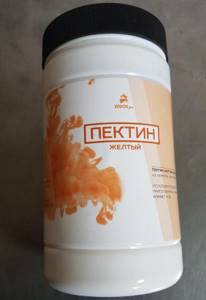
LM pectins do not require sugar to set, they need calcium. They can be used to add thickness and viscosity not only to sweet confectionery products. This type of pectin is thermo-irreversible. However, every rule has an exception, especially when chemists get involved - NH pectin - a modernized LM-pectin that is thermoreversible.
Ingredients for raspberry jelly
- fresh raspberries - 0.5 kg;
- sugar - 250-300 g;
- apple pectin - 25 g;
- citric acid (if the raspberries are sweet/overripe) - 0.5 tsp.
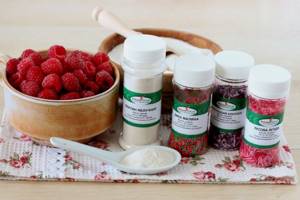
Preparation time: 5 minutes
Cooking time: 40 minutes
Number of servings: 10-15 pcs.
Cuisine of the world: European
Preparation method: Preparation
Nutritional value of 100 grams of prepared raspberry and pectin jam: calorie content - 385 kcal, 2.5 g protein, 0.04 g fat, 86 g carbohydrates
Jelly preparation options
From black currant
Currants are quite juicy berries, so you can extract the juice from them using a juicer. If this unit is not available, then the easiest option is to blanch the berries and grind them through a sieve.
To do this, boil 2 cups of water in a saucepan. Place washed black currant berries (2 kilograms) into boiling water and, stirring constantly, boil for 5 minutes. The hot berry mass along with the broth is thrown onto a metal sieve placed on another bowl. The fruits are ground with a wooden spoon or spatula. The cake is later used for cooking compote or jelly.
The resulting currant mass is poured into a wide basin or pan. The bowl into which the berries were ground is not washed immediately. It is needed to measure the amount of juice obtained. A trace of berries remains on its inner wall. To measure, pour water into a bowl to this mark, and then pour it into the sink using a liter jar. Thus, it is easy to calculate how much currant juice is obtained.
For every full liter of juice, take 800 grams of granulated sugar. Sugar is introduced gradually, slowly heating the berry mass over medium heat. After 30 minutes, when there is practically no thick foam on the surface, the jelly is poured into jars and immediately twisted.

You may also find recipes for making vitamin jelly from quince and red rowan juice useful.
From orange juice on agar-agar
Wash the skins of 6 large oranges thoroughly with a brush. To remove the zest, leave one of the fruits, the rest are peeled. The zest is removed with a fine grater or a small knife. The cut should be thin so as not to touch the white part of the peel. After removing the zest, the citrus is cleaned.
The oranges are then passed through a juicer or crushed in a blender. The pulp is filtered through cheesecloth or a sieve with a fine mesh.
A glass of water and half a kilo of sugar are added to the resulting juice. The fruit mass is placed on the fire. Use dishes with a wide bottom so that the jelly boils faster. After 10 minutes of cooking, add a teaspoon of agar-agar to the aromatic syrup. To ensure that the powder spreads evenly without leaving lumps, it is mixed with the same amount of sugar. Cook the jelly for another 3 minutes and turn off the heat.
Jelly on agar-agar sets when cooled, even at room temperature. If you plan to make the jelly for the winter, then pour it while still hot into pre-prepared jars.
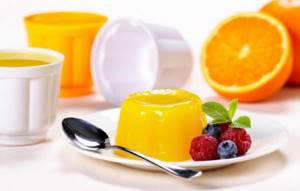
From packaged store-bought juice on agar-agar
Absolutely any juice is suitable for this recipe. The liter bag is opened and the contents are poured into a wide saucepan. A kilogram of sugar is also added to the bowl. The juice is boiled over medium heat for 10 minutes, and then agar-agar (a tablespoon) is added. To prevent the powder from clumping while dissolving in the jelly, it is mixed with sugar 1:1.
Boil the sweet mass for 3-5 minutes, no longer. The finished jelly is laid out in molds or packaged in glass jars for storage for the winter.
The SkyMan channel suggests making jelly from boxed juice and gelatin
From apricot juice on gelatin
15 grams of gelatin powder are poured with 50 milliliters of boiled water at room temperature. The granules are mixed and left to swell.
A kilogram of apricots is washed. Each fruit is cut into halves and the seeds are removed. Pieces of fruit are dipped in boiling water (500 milliliters) and blanched for 5 minutes. Then the fruits are thrown together with the broth onto a metal sieve and, stirring vigorously, they are ground through the grate.
The resulting juice is mixed with sugar (1.2 kilograms) and placed on the stove for 25 minutes. The entire cooking process is carefully controlled: the mass is periodically stirred and foam formations are removed.
At the very end of cooking, the swollen gelatin paste is introduced. The jelly is quickly stirred until the grains are completely dissolved and the heat is immediately turned off, not allowing the fruit mass to boil.
Hot gelatin jelly is poured into jars, screwed on with sterile lids, and after cooling, put in a cool place.
This jelly should not be kept warm for a long time before use. It holds its shape perfectly only when chilled.
Watch a video from the “Cooking at Home” channel about preparing two-color jelly based on sour cream and cherry juice
From frozen sea buckthorn juice with gelatin
Many people freeze sea buckthorn fruits to prepare delicious vitamin-rich fruit drinks and compotes in the winter. We suggest that you familiarize yourself with the recipe for making delicious jelly from the juice of frozen berries.
Place 2 cups of frozen sea buckthorn in a container with high sides. The berries are poured with boiling water (600 milliliters), and after 5 minutes the melted fruits are crushed with a submersible blender. The juice is filtered through a fine strainer. The cake is used to prepare sea buckthorn oil.
Add 3.5 cups of sugar to the strained mass, which is dissolved by boiling the berry juice for 10 minutes. At the final stage, add 20 grams of gelatin, diluted in a 1:2 ratio with cool boiled water. The gelatin is soaked about 30 minutes in advance.
The jelly is heated without bringing to a boil, and then poured into jars or into shaped molds.
In addition to frozen berries, jelly can also be made from fresh fruits. Details here.

From blackberries with pectin
Finding pectin powder in stores today is not difficult. You don't need much of it to make jelly. A bag (10 grams) is enough for you to prepare a dessert from 1 kilogram of blackberries.
Ripe berries are rinsed under running water. There is no need to dry them on a wire rack. The prepared fruits are transferred to a saucepan and filled with water (200 milliliters). Close the lid and simmer the blackberries over low heat for 10 minutes.
Steamed berries are punched with a blender and filtered through a sieve or cheesecloth. Sugar is added to the dark aromatic juice. Its quantity is calculated based on the amount of juice obtained. For every liter you will need 1 kilogram of sand.
It takes approximately 15-20 minutes to boil the syrup. At this time, a bag of pectin is combined with a teaspoon of sugar and mixed until smooth.
Pectin powder and sugar are poured into the thickened berry mass in a thin stream. Constantly stirring the jelly, keep it on the fire for another 5 minutes, no more.
The blackberry transparent dessert is packaged in jars until it has cooled down.
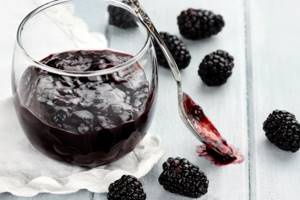
Lingonberries with apple skins
Lingonberries themselves are rich in pectin, but even more of this substance is contained in the skins of sour apple varieties.
Pour 2 cups of water into the pressure cooker. Bring the water to a boil without using the pan lid. The skins of 5 apples and a kilogram of lingonberries are placed in the seething liquid. After this, the lid is immediately closed and screwed on. A steam release valve is installed on top.
Set the fire to maximum power and wait for the liquid inside to boil. This will be signaled by the pressure of steam coming out of the valve. At this moment, the fire is reduced to a minimum value. Boil berries with apple skins in this mode for 10 minutes.
Then the boiled fruits along with the liquid are poured through a sieve into a wide container. To make the juice more transparent, the grate is first covered with gauze.

Sugar is added to the resulting juice at the rate of kilogram per liter. The syrup is placed on the fire and boiled until the mass is reduced in volume by at least 1/3.
Check the readiness of the dish by dipping a spoon in the jelly. If the berry mass flows from the spoon in a thin, continuous stream, then the jelly is ready. It is poured straight from the fire into jars and sealed with clean lids.
We also suggest making jelly from the juice and peel of apples according to the recipe from the Black Chef channel.
"Raw" viburnum jelly
Place 1 kilogram of fully ripened viburnum berries in a colander (you can directly with the twigs) and scald with boiling water. Then the sieve is immediately moved to the cooking pan and they begin to press the viburnum through the grate. This is done with a spoon or a wooden potato masher. Be careful, viburnum juice can splash the entire kitchen!
The collected juice is mixed with 800 grams of sugar. It is necessary to ensure that the crystals are completely dissolved before putting the jelly into jars. This dessert retains all the vitamins without cooking, but, unfortunately, it does not last long.
You can store the winter preparation of viburnum juice for a longer time by boiling the dessert over a fire. Detailed instructions are presented in our article.
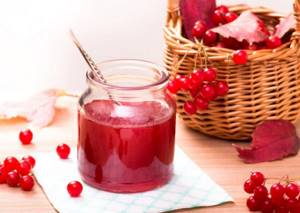
Step-by-step recipe for raspberry and pectin jelly
To prepare a very tasty and aromatic jelly from berries with pectin, take the freshest raspberries and apple pectin per 1 kg of berries - at least 20 g of pectin. If you are confident in the quality of your raw materials, you don’t have to wash the raspberries. If you purchased raspberries at the market, be sure to rinse the berries under running water to remove debris or dust, and let the water drain through a sieve or colander.
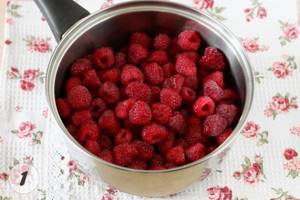
Cover the raspberries with sugar and let them release their juice.

Raspberries are a very juicy berry with a delicate skin, so the necessary syrup immediately appears in the saucepan.

Place the resulting mass on the fire and simmer for 5-7 minutes until the berries soften.
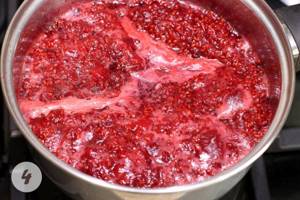
Place the raspberries in a sieve and rub through the wire rack, leaving all the seeds behind. Let the raspberry puree cool to 45-50 degrees. It is at this temperature that it is recommended to introduce any type of pectin.

In the meantime, you need to prepare the pectin. If you simply pour it into raspberry puree, it will form lumps that cannot be dissolved with any effort, which means that the ability to convert the liquid into jelly will be reduced significantly. Some culinary sources advise making liquid pectin first and describe how to dissolve pectin in water. You can use these recommendations, or you can do it easier and faster: mix pectin with 3-4 tbsp. sugar and fearlessly pour the resulting bulk mixture into the puree.
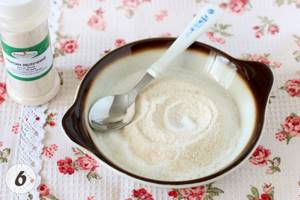
How to prepare jelly with pectin: when the raspberry puree has cooled to 45 degrees, you need to add a mixture of pectin powder and sugar to the berry mass. At the same time, you can stir the syrup with a whisk so that the mixture disperses better in the liquid.

The last thermal process should not last more than 3-5 minutes. We want to repeat once again, if your raspberries are very sweet, we recommend adding a little citric acid to start the gelling process. After 3 minutes of active boiling, remove the raspberries from the stove and let them cool. Pectin begins to show its effect when cooled, and this is how jelly with pectin is prepared!
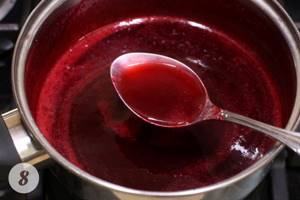
If you are preparing jelly with pectin for the winter, prepare the jars in advance, sterilize them along with the lids, and then pour the finished raspberry confiture with pectin into glass containers.
You can make this raspberry jelly as a regular dessert - then all you need to do is pour it into bowls while it is still warm, and then place it in the refrigerator. After 5-7 hours, the jelly will finally stabilize and take on a jelly-like consistency.

We hope that you will no longer shy away from pectin, but will be happy to use it in home cooking! After studying our recommendations, you will be able to independently select recipes for desserts with pectin, as well as easily prepare raspberry jam with jam or jelly with pectin for the winter!
Popular queries: recipes with pectin, jelly with pectin for the winter, berry jelly with pectin, making jelly with pectin, how to thicken jam with pectin

Recipe author: Mishchenko Yu.
Author of the article: Stevlinskaya V.G. (Associate Professor KNRTU)
Publication date: 10-06-2019
Update date: 02-08-2019
Copyright holder: Deluxe Spice Shop
There are no similar posts
Technology for making jelly from juice
The first step is to decide on the main product. Berries and fruits contain a natural thickener - pectin, but some fruits have more of it, others have less. Depending on the main ingredient and the content of gelling components in it, the preparation recipe will change. Fruits with a high pectin content (apples, currants, viburnum, cranberries) do not require the use of large amounts of sugar and additional thickeners when preparing jelly. Conversely, berries and fruits without pectin, or containing it in small quantities (for example, raspberries, apricots, oranges) cannot do without additional investments in the form of sugar and gelling additives.
Fresh berries and fruits are processed into juice. This is done using a juicer, juicer, or by boiling the fruits in a small amount of water, then grinding through a sieve and straining.
Then sugar is added to the juice and the mass is boiled over medium heat until the volume decreases by 1.5 - 2 times. Just before the end of cooking, a gelling component is added to the jelly, if necessary.
The finished dessert, without removing the bowl from the heat, is packaged in sterile containers and screwed on with lids scalded with boiling water.
